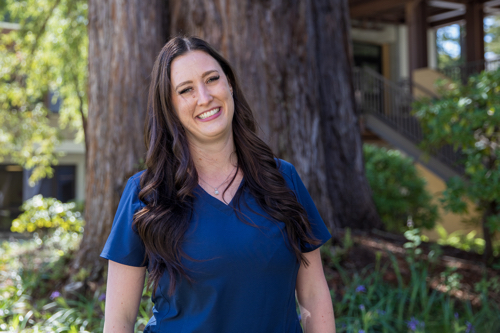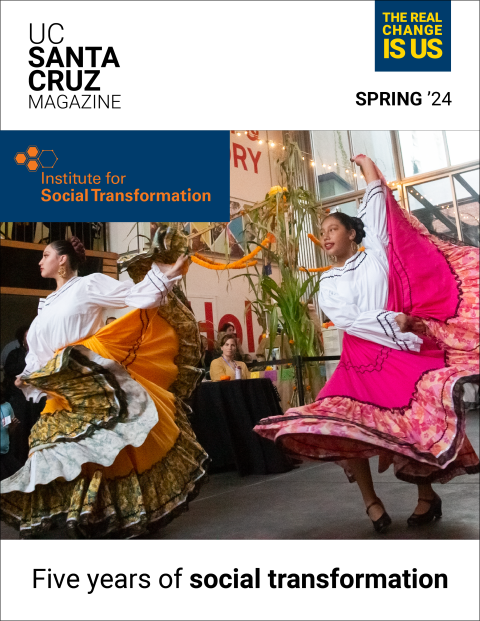Starting a new job and moving to a new area is hard no matter what, but how about trying that with a broken foot in the middle of a pandemic and rampant wildfires?
Larissa Mangas, the clinic director at UC Santa Cruz Student Health Center, faced all of that last year. Mangas arrived at her new job having recently injured her foot and wearing a walking boot. Just two days after she started her position March 9, 2020, the campus shifted to remote operations due to COVID–19 restrictions. Five months after that, she and her husband and pets were suddenly evacuated in the middle of the night because of wildfire. While her home was saved, her three immediate neighbors’ houses were destroyed.
“The first few months were a whirlwind for sure,” Mangas said.
Mangas moved from Long Beach in January and was just starting to settle in when she began her new job. After the shutdowns, she had to jump into action to help get telehealth services started at the student health center. The office had never offered telephone appointments for patients before and the process would have normally taken a solid year to get off the ground. “We got it done in less than two months,” she said.
The next big challenge was getting COVID–19 testing going last summer. She and others had to figure out how to coordinate all the logistics including setting up a site in a parking lot, figuring out patient scheduling, coordinating with the Molecular Diagnostic Lab, which processed the tests, and integrating testing into their electronic medical record.
Mangas said she never worried about her or other health workers’ safety from COVID–19 at the university because the student health center always had enough supply of personal protective equipment like masks, gowns and gloves. In addition, she didn’t work much with patients directly and was working more on administrative tasks.
What was much more difficult was trying to follow the constantly changing guidance about how to manage the disease. One day she would train nurses in COVID–19 protocols. “The next day, the guidance changed and we had to change everything we did,” she said. “That happened over and over the first few months.”
The August wildfire presented more upheaval. One night at 1 a.m., Mangas and her husband had to leave their home with their pets to flee approaching flames. They spent that first night sleeping in their truck in the Student Health Center parking lot. They later moved to a hotel with their cat, dog and a rabbit and left three ducks to board at an animal shelter.
Coping with the unknown was hard. They didn’t know how long they would have to evacuate or if they would lose the house. She thought, “I’ve only lived here eight months and I might lose all my belongings.”
Mangas was touched by the outpouring of support from her new colleagues at work who checked in on her and offered to provide space for her animals. It was hard for her to meet anybody else outside of work because of the pandemic restrictions.
At the beginning of this year, the new challenge was figuring out how to distribute the new COVID–19 vaccines. It was Mangas’ job to set up the clinics.
Beginning in January, the university offered vaccinations to the student health center staff first and then offered shots up to the greater campus community including faculty, staff, student workers and other affiliates. She set up vaccination sites at a COVID testing kiosk on campus, went to the daycare center to vaccinate staff there, and then set up the clinic at the Cowell Hay Barn.
“There was a large demand,” she said. “There was a time when people were calling us trying to get in and we were full and we didn’t have the vaccine or capacity for everyone calling us,” she said. Later on, it became easier to serve everyone.
But even in the most difficult time, the vaccination process moved smoothly. “People did not have to wait hours and hours,” she said, as was the case in some locations around the country. “Maybe the longest wait in line was 15 minutes.”
All in all, the university provided 5,200 vaccines through April.
Now, at last, things seem to be settling down and Mangas is busy preparing for fall and what is hoped to be the full return of students to campus. She is grateful that she can go back to focusing on the core operations of the student health center. “I can breathe,” she said. “I’m able to focus on doing the rest of my job now.”



